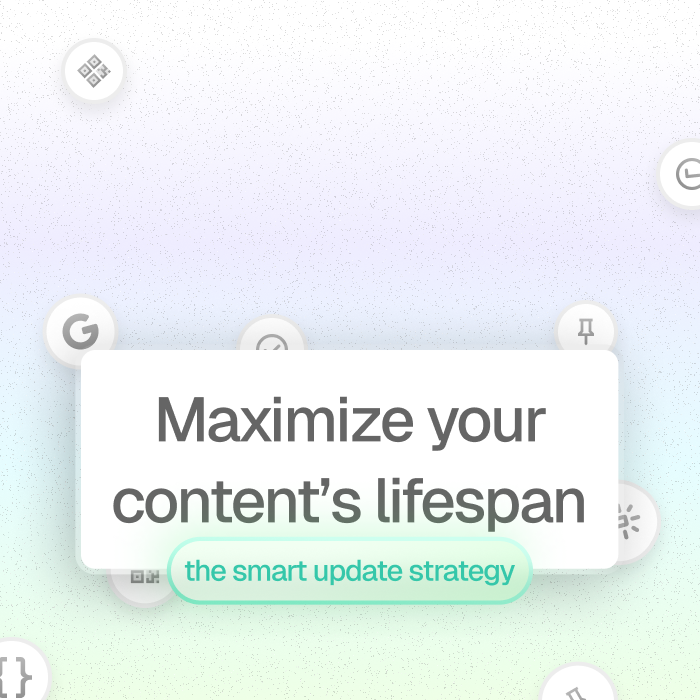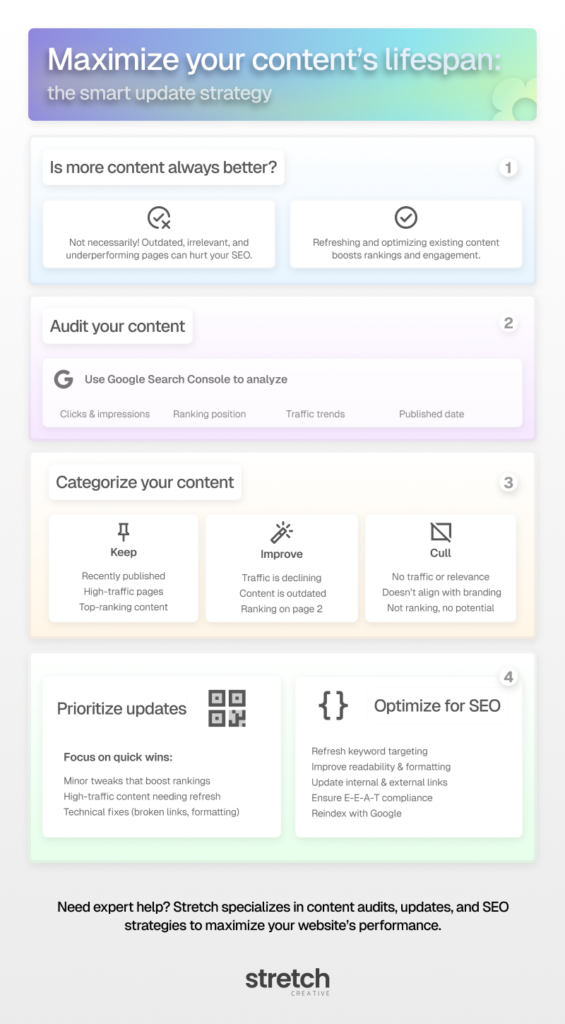
Is more content always better? Not necessarily.
You may have heard digital marketers say that all content is good content, but that’s not entirely true. Outdated Content, irrelevant, and underperforming pages can drag your rankings down.
Search engines prioritize high-quality, relevant, and useful content that provides value to users. If your website is filled with outdated content, including outdated Content, broken links, or information that no longer aligns with current trends, it can negatively impact your rankings. This is why regularly auditing and revitalizing outdated Content is crucial for maintaining and improving your website’s performance.
Instead of focusing solely on producing new content, repurposing and updating existing outdated Content is a powerful strategy to improve search rankings, increase traffic, and enhance engagement. Updating outdated Content extends the lifespan of your best-performing pages, helps boost your website’s authority when traffic plateaus, and maximizes the return on your initial content investment. By working smarter, not harder, you can make the most of what you already have while still ensuring your site remains fresh and relevant.
How to determine what outdated content to improve
Running a content audit helps identify which pages need to be updated, removed, or left alone. A thorough audit not only improves rankings but also ensures your audience receives the most accurate and relevant information.
To start, use Google Search Console to analyze the past 12–16 months of data. Focus on key metrics like:
- Clicks: How often users are clicking on your content.
- Impressions: The number of times your content appears in search results.
- Position: Where your content ranks on Google.
- Published Date: The last time the content was updated.
Once you've gathered the data, categorize your content into three groups:
- Keep: No changes needed.
- Edit: Update content and refresh SEO.
- Cull: Remove from your site.
The exact categorization will depend on your overall site performance, but here are some general guidelines:
Keep:
- Recently published content that hasn’t been live long enough to generate substantial data.
- Content that consistently generates a high volume of traffic.
- Pages that rank well on search engines.
Improve:
- Posts that still receive traffic but have shown a decline over the last 3–6 months.
- Content that has decayed, losing significant organic traffic over time.
- Articles ranking on the second page of search results and within striking distance of the first page.
- Evergreen content that remains relevant but needs minor updates to stay fresh.
- Posts targeting high-intent, high-volume keywords that aren’t ranking as expected.
Cull:
- Pages receiving little to no traffic.
- Content that is no longer relevant or does not align with your brand’s goals.
- Articles that are not ranking and have no opportunity for improvement.
- Duplicate or thin content that adds no real value to users.
Prioritize your updates
After categorizing your content, prioritize updates based on the easiest and quickest wins. Consider the following factors when determining which content to update first:
- Quick Wins: Minor tweaks that boost rankings and make content evergreen should come first.
- High-Impact Content: Posts that generate significant traffic but have dropped in rankings due to outdated information.
- Competitive Pages: Content that is performing well but could overtake competitors with slight adjustments.
- Technical Issues: Pages with broken links, poor formatting, or outdated references should be fixed immediately.
More extensive revisions should be lower on the priority list unless the content is highly relevant, still attracting significant traffic, or essential to your business goals.
How to revive an old blog post
Once you've identified content worth updating, follow these steps to refresh it effectively:
Refresh keyword targeting: Ensure you're optimizing for the right search terms that align with user intent.
Update content for relevance: Check for outdated statistics, add new insights, and ensure the article is authentic and engaging.
Optimize for E-E-A-T (Expertise, Experience, Authoritativeness, Trustworthiness): Google values high-quality content from credible sources.
Improve on-page SEO: Adjust headers, meta descriptions, titles, internal/external links, and keyword placement to enhance discoverability.
Add and optimize media: Incorporate high-quality images and videos to improve engagement and readability.
Enhance formatting and readability: Improve structure by using bullet points, subheadings, and clear, concise sentences.
Correct typos and grammar errors: Ensure a polished final product that reflects professionalism.
Update the publish date: Reflect the latest edits to signal freshness to search engines.
Reindex the post with Google: Ensure search engines recognize the updates so they can be reflected in search results.
By following these steps, you can breathe new life into old content, increasing its potential to rank higher and attract more traffic.
Maximize your content’s lifespan

The digital world moves fast, but that doesn’t mean older content has to become obsolete. A well-maintained blog or website continuously evolves, staying relevant and valuable to its audience.
Working smarter beats working harder. By extending the usefulness of your existing content, you improve your website’s performance and reduce the pressure of constantly producing new material. With a strategic approach to content updates, you can keep your site ranking high, engaging users, and driving consistent traffic without starting from scratch every time.
Want to take your content strategy to the next level? Contact Stretch for a professional content audit. We’ll help revitalize old posts, improve underperforming content, and create expert-quality new content so your site performs at its best.